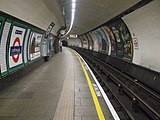| Tooting Bec | |
|---|---|
 The station entrance | |
| Location | Tooting |
| Local authority | Wandsworth |
| Managed by | London Underground |
| Owner | London Underground |
| Number of platforms | 2 |
| Fare zone | 3 |
| London Underground annual entry and exit | |
| 2019 | |
| 2020 | |
| 2021 | |
| 2022 | |
| 2023 | |
| Railway companies | |
| Original company | City and South London Railway |
| Key dates | |
| 13 September 1926 | Opened as Trinity Road (Tooting Bec) |
| 1 October 1950 | Renamed Tooting Bec |
| Listed status | |
| Listing grade | II |
| Entry number | 1065477[6] |
| Added to list | 16 June 1987 |
| Other information | |
| External links | |
| Coordinates | 51°26′09″N 0°09′32″W / 51.435833°N 0.159°W |
Tooting Bec, originally Trinity Road (Tooting Bec), is a London Underground station in Tooting, South London. The station is on the Northern line, between Balham and Tooting Broadway stations. It is located on the junction of Trinity Road (heading north-west), Upper Tooting Road (south-west), Balham High Road (north-east), Tooting Bec Road (south-east) and Stapleton Road (also south-east). The station is in Travelcard Zone 3.
History
[edit]
The station was designed by Charles Holden and opened on 13 September 1926 as part of the Morden extension of the City & South London Railway, which is now part of the Northern line. Originally known as Trinity Road (Tooting Bec), it was given its present name on 1 October 1950.[7]
The narrow satellite building on the east side of the junction provides pedestrian subway access to the station and is unusual in that it has a large glazed roundel on each of the three panels of its glazed screen, as normally the Morden extension stations have the roundel in just the centre panel. For many years the northern panel of the screen was the sole example on any of the Morden extension stations to retain the 1920s "UNDERGROUND" lettering, the other stations' screens having been replaced with plain glass over the years. All the stations have now had the original motif replaced along with the flag-pole-mounted roundels that had been removed in the 1950s.
On the platforms the station has two examples of clocks from the Self Winding Clock Company of New York City.
Connections
[edit]London Buses routes 155, 219, 249, 319 and 355 and night route N155 serve the station.
References
[edit]- ^ "Station Usage Data" (XLSX). Usage Statistics for London Stations, 2019. Transport for London. 23 September 2020. Archived from the original on 9 November 2020. Retrieved 9 November 2020.
- ^ "Station Usage Data" (XLSX). Usage Statistics for London Stations, 2020. Transport for London. 16 April 2021. Retrieved 1 January 2022.
- ^ "Station Usage Data" (XLSX). Usage Statistics for London Stations, 2021. Transport for London. 12 July 2022. Retrieved 7 September 2022.
- ^ "Station Usage Data" (XLSX). Usage Statistics for London Stations, 2022. Transport for London. 4 October 2023. Retrieved 10 October 2023.
- ^ "Station Usage Data" (XLSX). Usage Statistics for London Stations, 2023. Transport for London. 8 August 2024. Retrieved 16 September 2024.
- ^ Historic England. "Tooting Bec Station (Including Above Ground Buildings and Sub Surface Platforms and Passages) (1065477)". National Heritage List for England. Retrieved 3 April 2015.
- ^ "London Underground History – Cut and Cover Disused Stations".
Gallery
[edit]-
Northbound platform looking south
-
Southbound platform looking north
-
Station platform roundel
-
The escalators with uplighters at Tooting Bec
External links
[edit]| Preceding station | Following station | |||
|---|---|---|---|---|
| Balham | Northern line Morden branch
|
Tooting Broadway towards Morden
| ||




